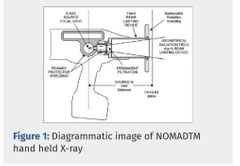![]()
![]()
![]()
Use LEFT and RIGHT arrow keys to navigate between flashcards;
Use UP and DOWN arrow keys to flip the card;
H to show hint;
A reads text to speech;
5 Cards in this Set
- Front
- Back
|
Diagram of handheld xray device |

|
|
|
The hand held devices are used as a replacement for wall-mounted or semi mobile X-ray devices (on a tripod or mobile support) and differ in two major characteristics from those |
. :The operator holds the hand-held portable X-ray devices during exposure of the patient, so the operator cannot stand back of radiation protection shields, and therefore, dedicated means of (scatter) radiation protection need to be providedThe newer handheld devices have typically a lower output dose rate (set by current, waveform, filtration and cone length) than the traditional wall-mounted direct current units. |
|
|
Hand-held portable X-ray devices should only be used in specific cases where it is impractical or impossible to transfer the patient to a fixed mounted X-ray installation and use of mobile devices are not practicable, such as in |
Operation theatres where no fixed mounted X-ray unit is available and the patient is under general anesthesia or sedation. The first choice in this case should be a semi-mobile deviceEmergency rooms, surgical suites, patient rooms, or other hospital facilities for immobile patients. The first choice in this case should be a semi-mobile deviceNursing homes, residential care facilities, or homes for persons with disabilities, which compromise mobility or their general health and who are thus unable to attend a healthcare facility. |
|
|
Details |
The hand-held X-ray device uses direct current, operates at a fixed 60 kV, 2.3 mA, and has a 0.4 mm focal spot with a 20 cm source-to-skin distance Lead apron applicable in hand-held X-ray: The operator to stand at least 1.5 m away from the tube head and patient; lead apron of at least 0.25 mm lead equivalency is needed |
|
|
Disadvantages of hand-held radiography |
The main drawback is that ALARA principal is not followedThe device must be angled and the operator cannot be completely within the protection zoneCompulsory lead apron is necessarily should be worn by the operatorSome time the radiofrequency which is used to produce X-ray leads disturbs other operating machinesAn experienced operator is needed. |

